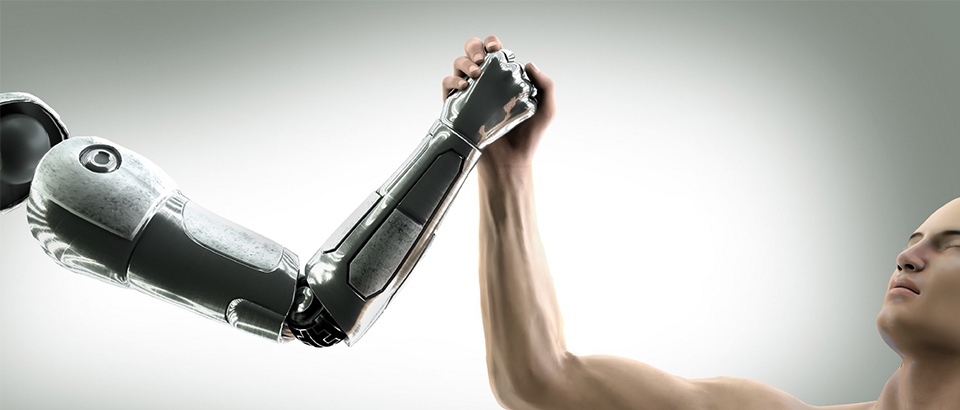Man vs. Machine: Can Humans Be Replaced?

Man vs. machine in hair transplant. This was a recurring topic at the recent DHI Masters, an annual meeting of hair restoration experts. And for good reason, as more and more clinics practice automation in hair transplantation, through robots, machines, or automated punching.
But can these techniques compete with manual transplant methods, especially with the DHI method? Can a machine really replace an expert eye and steady hand in the hair transplant? Automated methods have real benefits, but they are not without drawbacks, especially for patients.
What is Automated Hair Transplantation?
Any hair transplant method that uses a machine for any stage of the hair transplant can be considered "automated." For clinics, automating some part of the transplant procedure is an attractive option to save time and money. It is faster than doing the transplant by hand and allows even lower-skilled technicians, rather than doctors, to perform the procedure.
Automation is most often used to extract or remove the follicles from the donor area. Automated Follicular Unit Extraction (IFA), for instance, is follicle extraction done by a machine like Safer® or the Artas® robot. Some clinics, especially those that advertise "low-cost transplants" in countries like Turkey, even use automated punching to extract the follicles.
Safer® also uses an automated punch but with a programmable rotating head that's equipped with a vacuum cleaner. Once the follicles are aspirated, the grafts stay in the storage chamber where they wait to be implanted. From a handpiece, with a plunger, the grafts are blown into incisions previously made in the recipient area.
With Artas®
The Artas® robot uses digital imaging technology to map and analyze the natural clusters of hair on the patient's scalp. An American company invested hundreds of thousands of dollars in this technology and promised, once tuned, the 3D scanner system could analyze the orientation, angle, depth, and density of the hair.
The American company that developed this innovation invested hundreds of millions of dollars in this "revolution" by promising that once tuned, the 3D scanner system could analyze the orientation, angle, depth and the density of the hair.
Advantages of Automated Systems
The use of automated systems, whether via robots or motorized punches, reduces the time it takes to perform a hair transplant. It also reduces the number of staff required for the procedure. Automation cuts costs for both the clinic and the patient. But is the time and money saved really an advantage for the patient?
Robots like Artas® require an operator with less experience, so they are a good investment for doctors adding hair transplants as a new activity in their offices.
The Limits of Automated Hair Transplantation
Like more established manual methods--FUT or FUE--automated grafting methods focus on the extraction phase to the detriment of the implant phase, which is much more important for the outcome.
Safer® and NeoGraft®
- The larger diameter and the rotation of the automated follicle extraction punch can produce "moth-effect" scars on the donor area.
- The angle of penetration of the rotating handpiece is not always identical to that of the axis of the follicle under the skin (which may sometimes be different from the direction of the hair coming out of the scalp), which results in transected (sliced) follicles.
- The air of the aspirator dries the grafts and compromises their survival. This can affect the regrowth rate.
- The second handpiece (equipped with a piston) was originally designed to push the grafts into the incisions made in the scalp. Though most doctors find it impractical and just manually implant the grafts. The practitioner or technician uses forceps to place the grafts into the holes or incisions, just as they would in more traditional methods (FUE and FUT).
- Beyond the extraction, when a scalpel is used to create an incision in the scalp, the diameter is larger than the target of 1 millimeter. This can create a pattern of tiny divets, leaving the patient with an orange peel effect. This method is also not ideal for controlling the angle and direction of regrowth.
Artas®
- Once programmed, this machine does not require the presence of a hair transplant doctor. A less-experienced technician can do the work.
- Each graft is then reimplanted in the same way as in FUT (or "strip" method), with forceps placing follicles in reception holes (or slots) previously made.
- In practice, the software has limits. It scans only the outer part of the scalp, making it difficult to anticipate the orientation of the follicles under the skin.
- Extraction punches are often much larger in diameter than those used in manual FUE.
- It is difficult to use Artas® for sampling on the sides and periphery: the most experienced doctors, therefore, often choose to move to manual extraction.
- Despite the high development costs, the machine comes with few benefits compared to the FUE manual method to the patient.
From Ready-To-Wear...to Haute Horlogerie
Who would you blame for wearing a Swatch watch? Nobody. The brand is known worldwide, for its trendy affordable designs. But you would never compare a Swatch to a meticulously-crafted watch by Swiss master watchmaker Patek Philippe.
For transplants, it's the same. Precision is de rigueur; the result must be impeccable. The hair transplant procedure is medicinal, mathematical, and artisanal, mastered by experts who have invested themselves in the field.
But is not an intervention like this primarily a human relationship between a doctor and his patient? As a human being, we treat patients with ... humanity, with human feelings, like the human ideal of beauty. It's something a machine just can't replicate.


